 The Divergent Dynamics of Economic Growth
The Divergent Dynamics of Economic Growth Book contents
- Frontmatter
- Contents
- Preface
- Acknowledgments and Comments
- 1 The Adaptive, Evolutionary Theory of Divergent Economic Growth
- PART ONE GLOBAL TRENDS AND ADAPTIVE ECONOMICS
- PART TWO TECHNOLOGICAL CHANGE IN AGRICULTURE AND INDUSTRY
- 4 The Economics of Technological Change and the Demise of the Sharecropper
- 5 Economic Development as an Adaptive Process
- 6 Industrial Development and Technological Change
- 7 An Adaptive Economizing Analysis of Chinese Enterprises Under Alternative Reform Regimes
- PART THREE EPOCHAL DEVELOPMENT
- PART FOUR TOWARD A GENERAL THEORY OF DEVELOPMENT
- Index
6 - Industrial Development and Technological Change
Published online by Cambridge University Press: 08 August 2009
- Frontmatter
- Contents
- Preface
- Acknowledgments and Comments
- 1 The Adaptive, Evolutionary Theory of Divergent Economic Growth
- PART ONE GLOBAL TRENDS AND ADAPTIVE ECONOMICS
- PART TWO TECHNOLOGICAL CHANGE IN AGRICULTURE AND INDUSTRY
- 4 The Economics of Technological Change and the Demise of the Sharecropper
- 5 Economic Development as an Adaptive Process
- 6 Industrial Development and Technological Change
- 7 An Adaptive Economizing Analysis of Chinese Enterprises Under Alternative Reform Regimes
- PART THREE EPOCHAL DEVELOPMENT
- PART FOUR TOWARD A GENERAL THEORY OF DEVELOPMENT
- Index
Summary
This study summarizes four models that track production, investment, technological change, and resource utilization in the U.S. coal industry and the steel industries of the United States and Japan. The post–World War II history of these industries is one of rapid technological change accompanied by large investments and capacity accumulation. Consequently, we focus on the technological structure of each industry and on the economic rules determining production and investment plans. Although the behavioral and technological structures of the three industries vary in many significant details, they share several common features that make possible the application of logically similar modeling techniques. Our goal has been to derive a positive understanding of the development process in particular industries based on microeconomic realities, in a manner that might guide government agencies whose concern is not so much with the internal performance of the industries in question as with the external macroeconomic effects of their production, investment, and resource utilization behavior.
After a brief description of the industries, we present a nontechnical description of our work. Important properties of the models are summarized, and their implications for explaining chronic excess capacity are outlined. We then review our estimation and testing methods, describe a few preliminary empirical results, and comment on their policy implications.
In all three cases under consideration, rapid changes in technology have occurred. In coal mining three basic types of production are practiced: underground, strip, and auger mining.
- Type
- Chapter
- Information
- The Divergent Dynamics of Economic GrowthStudies in Adaptive Economizing, Technological Change, and Economic Development, pp. 97 - 114Publisher: Cambridge University PressPrint publication year: 2003
